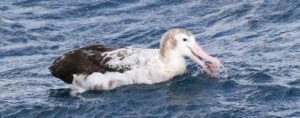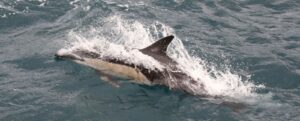 By Peter Ryan, onboard scientist, expert in general ornithology, seabird-fishery interactions, evolutionary ecology, marine debris, solid waste management, biology of oceanic islands.
By Peter Ryan, onboard scientist, expert in general ornithology, seabird-fishery interactions, evolutionary ecology, marine debris, solid waste management, biology of oceanic islands.
Leg 1, Day 29.
We had high expectations for our last full day at sea, but the ship slowed as we neared Tasmania, so we didn’t cross the continental shelf in daylight. As a result, only 15 bird species were seen, the same total as yesterday, but there were a few new additions to the list. Most exciting for the birders was Gould’s Petrel, another Pterodroma petrel which is confined as a breeding species to the SW Pacific Ocean. Presumably the Shy Albatrosses seen (almost all adults) were predominantly of the Tasmanian form (sometimes split from the larger New Zealand population of ‘White-capped’ Albatrosses).
| Short-tailed Shearwater | 160 | Fairy Prion | 110 |
| White-chinned Petrel | 35 | Shy Albatross | 21 |
| White-headed Petrel | 14 | Gould’s Petrel | 8 |
| Wandering Albatross | 7 | Black-browed Albatross | 4 |
| Southern Royal Albatross | 2 | Mottled Petrel | 2 |
| Black-bellied Storm Petrel | 2 | Northern Giant Petrel | 1 |
| Soft-plumaged Petrel | 1 | Antarctic Prion | 1 |
| Common Diving Petrel | 1 |

